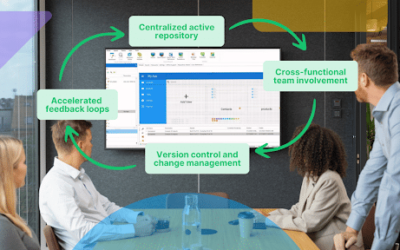IT departments like to think of themselves as gatekeepers to their organization’s infrastructure and systems—but that’s not always the case. The term “shadow IT” is now commonly used to describe software applications built and deployed without any organizational approval or support from the IT department. These projects typically happen because IT is seen as unresponsive or can’t deliver new web or mobile applications that are now expected by end users.
It’s likely you’ve witnessed some form of shadow IT. While short-term gains may have been achieved, your organization may be left with increased risk in addition to duplicated technologies and data.
We are also starting to see a new breed of non-professional developers, typically from the end user community, who have taken the development of these new apps and solutions into their own hands. They’re typically using drag and drop, low-code development tools and deploying these apps to cloud platforms or departmental servers. The term “citizen developer” is used to describe these individuals.
The Risk of Going Rogue
Many question if shadow IT and citizen development are good for organizations. But there’s an even more important question: What happens if IT lets the situation go unchecked?
Innovation born from new applications is clearly a good thing. Even better are bright end users who understand the business issues at hand and can define how we should improve applications. So, what’s the problem?
Well, left unchecked, these new styles of apps can lead to several key problems that will resonate with many CIOs, including:
- Duplicated data/master files and no single version of the truth.
- A lack of true workflow or process across business domains.
- Security concerns over access and control.
- The ability to scale and manage the application in an operational environment.
Embracing Change – The Best of Both Worlds
So how do IT departments reduce the risk of shadow IT when the resources or skills aren’t available to fulfill the types of projects that end users demand?
Most of the development community is focused on maintenance of existing legacy applications and older development standards and technology stacks. These don’t lend themselves well to newer agile development methods, which allow for rapid prototyping and deployment of new applications.
Gartner has coined the term “bimodal IT” to describe the practice of managing two separate but coherent styles of work. One section is focused on predictability (typically the domain of professional IT) and the other on exploration (typically the innovation projects created by citizen developers using low-code tools).
For the small to medium-sized business, the concept of bimodal IT may seem out of reach. So how might we embrace the beneficial aspects of shadow IT while implementing some control and oversight by IT professionals?
There are four topics you should consider:
- Collaboration with end users and business sponsors is one idea we can embrace and encourage. Many shops have grown accustomed to saying, “we can’t do it,” and this is exactly the type of event that triggers the shadow IT phenomenon. That can be easily changed.
- Prototyping is the next logical next step. Capture the ideas from collaborative brainstorming sessions and use a low-code or wireframing tool to visualize how these new apps might work.
- Low-code tools are now a recognized sector in IT covered by leading analyst firms such as Forrester and Gartner. They’ve emerged because it’s just too hard to build web and mobile apps from scratch using the myriad of programming languages needed to support these apps. Low-code tools are about making it simple to build transactional web and mobile solutions all the while reducing the complexity and maximizing productivity.
- APIs are the magic sauce that will enable you to integrate with your current applications. Typically, these are deployed as RESTful web services. This is one area where your development skills and knowledge will be very valuable to the projects you undertake. Many low-code tools provide assistance in creating these and can be configured to consume these services as needed.
Reaping the Rewards and Improving Productivity
It’s common for small development shops to spend most of their budget maintaining existing apps. They get locked into that cycle and struggle to break out. They can’t consider new projects due to resource constraints and the skills gap for building new, modern web and mobile apps.
The concepts and tools I just described can take new development down from weeks to days, and radically improve the productivity of your development team.
More importantly, the benefits can be significant:
- Central IT becomes the “single version of the truth” and can power new apps designed for the modern world.
- You’ve broken the constraint that of the older tech stacks used for current or legacy apps.
- The IT department may get more funding from the business once these concepts are proven out.
- Your developers can use tools that are less intimidating, which in turn will make them more productive.
With IT working alongside the business, it becomes far easier to avoid the problems described earlier and create an environment where collaboration is the norm.


























